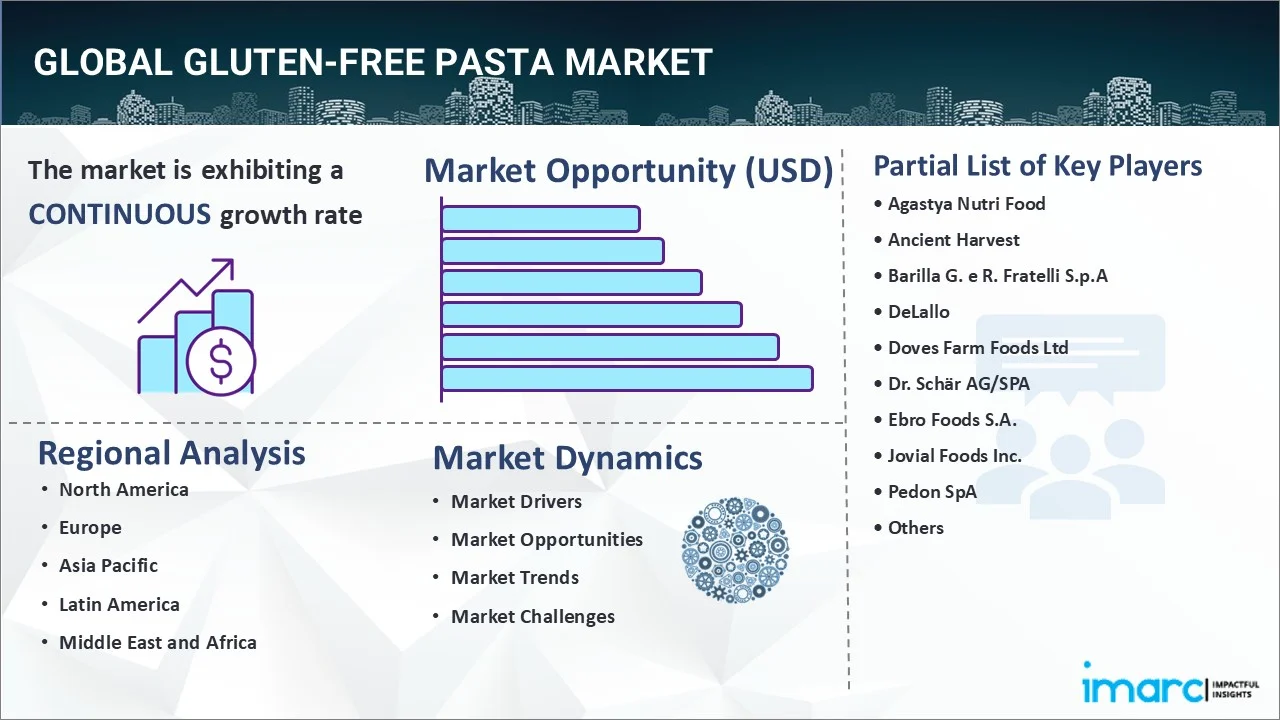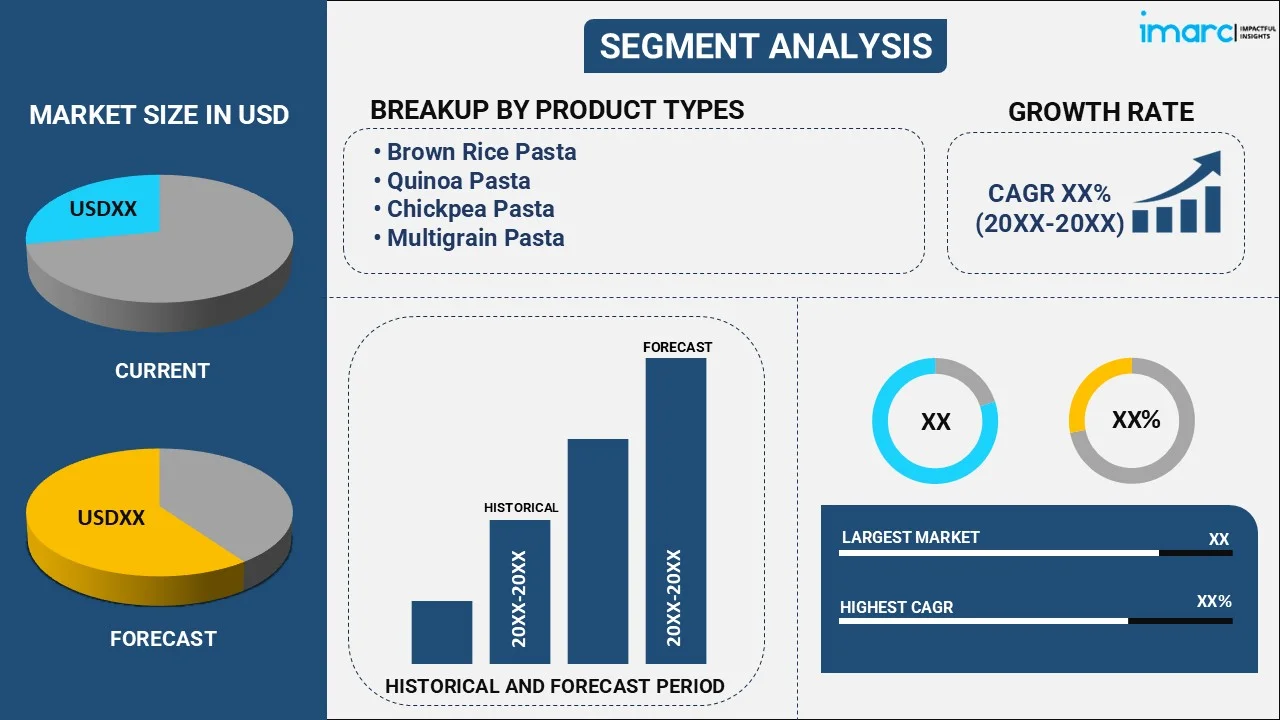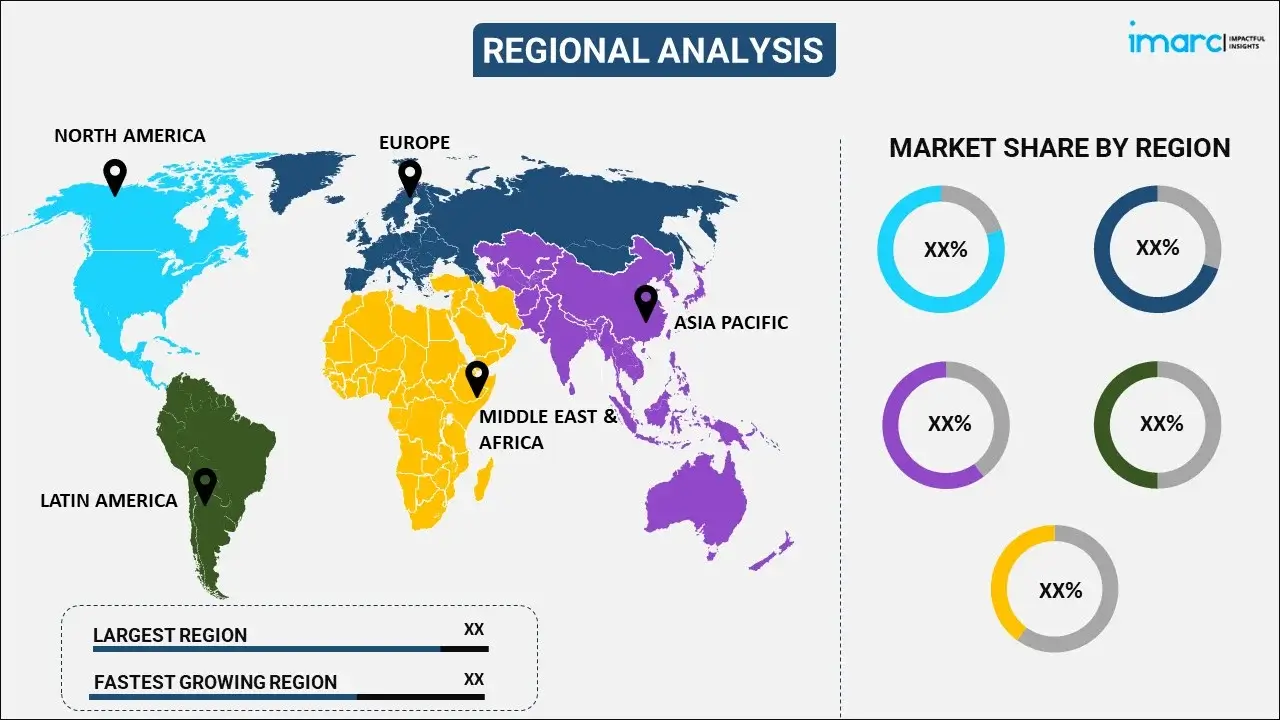
Gluten-Free Pasta Market Report by Product Type (Brown Rice Pasta, Quinoa Pasta, Chickpea Pasta, Multigrain Pasta), Type (Dried, Chilled/Fresh, Canned/Preserved), Ingredient (Rice, Corn, Millet, and Others), Distribution Channel (Supermarkets and Hypermarkets, Retail Stores, Convenience Stores, Online Stores), and Region 2025-2033
Gluten-Free Pasta Market Overview:
The global gluten-free pasta market size reached USD 1.33 Billion in 2024. Looking forward, IMARC Group expects the market to reach USD 2.26 Billion by 2033, exhibiting a growth rate (CAGR) of 5.78% during 2025-2033. There are various factors that are driving the market, which include the rising health consciousness among individuals, increasing demand for ready-to-eat (RTE) food products among people with busy lifestyles and hectic schedules, and the thriving food and beverage (F&B) sector.
|
Report Attribute
|
Key Statistics
|
|---|---|
|
Base Year
|
2024
|
|
Forecast Years
|
2025-2033
|
|
Historical Years
|
2019-2024
|
|
Market Size in 2024
|
USD 1.33 Billion |
|
Market Forecast in 2033
|
USD 2.26 Billion |
| Market Growth Rate 2025-2033 | 5.78% |
Gluten-Free Pasta Market Analysis:
- Major Market Drivers: One of the key market drivers includes the rising social media influence on individuals. Moreover, there is an increase in the awareness among people about celiac disease and non-celiac gluten sensitivity, which is acting as another growth-inducing factor.
- Key Market Trends: The rising health consciousness among individuals, along with the thriving F&B sector, is a main trend in the market.
- Geographical Trends: Europe exhibits a clear dominance accounting for the biggest market share because of its diverse culinary traditions.
- Competitive Landscape: Some of the major market players in the gluten-free pasta industry include Agastya Nutri Food, Ancient Harvest, Barilla G. e R. Fratelli S.p.A, DeLallo, Doves Farm Foods Ltd, Dr. Schär AG/SPA, Ebro Foods S.A., Jovial Foods Inc., Pedon SpA, RP's Pasta Company, The Hain Celestial Group Inc., The Kraft Heinz Company, Windmill Organics Ltd., among many others.
- Challenges and Opportunities: Higher production costs represent a key market challenge. Nonetheless, strategic partnerships and collaborations with health organizations, nutritionists, and dieticians, coupled with the rising focus on sustainable and ethical production practices, are projected to overcome these challenges and provide market opportunities.

Gluten-Free Pasta Market Trends:
Rising Health Consciousness Among the Masses
The increasing health consciousness among the masses across the globe is bolstering the market growth. There is a rise in the awareness about the impact of dietary choices on overall well-being. Individuals are becoming more informed about the potential health risks associated with gluten consumption, especially among those who have celiac disease or gluten sensitivity. Moreover, people perceive gluten-free diets as healthier, even if they don't have gluten-related health conditions. This perception eliminates gluten-based diets as they can lead to disruption in digestion. In addition, key players in the market are launching enhanced gluten-free pasta varieties to attract a wider consumer base. For instance, on 27 February 2023, Jovial's announced a new organic and gluten-free Mac & Cheese line. This new product line is launched with two SKUs, one made with white cheddar and one with dairy-free cheese, so they can be enjoyed by the whole family.
Increasing Demand for RTE Food Products
As per the IMARC Group's research report, the RTE food market is expected to reach US$ 181.5 billion by 2023. The rising demand for RTE food products among people with busy lifestyles and hectic working schedules is offering a favorable gluten-free pasta market outlook. Consumers are looking for quick and easy meal options. RTE food items such as gluten-free pasta meet this requirement by providing simple and instant meal options. RTE gluten free pasta that can be made in just a few minutes is considered a great option for families with busy schedules. In addition, the industry is growing because of the accessibility and availability of a variety of RTE food items. Consumers can find these products easily in supermarkets, convenience stores, and online retailers, which makes it convenient for them to incorporate gluten-free pasta into their diets.
Expanding Food and Beverage (F&B) Industry
The expanding F&B sector accommodates a broad range of consumer preferences including dietary needs and limitations. Furthermore, developments in the F&B sector are resulting in the creation of pasta that is gluten-free. Industry manufacturers are spending money on research and development (R&D) to produce gluten-free pasta products that satisfy dietary restrictions while also offering improved flavor and texture. Because of this innovation, a broader range of consumers will find gluten-free pasta more enticing as it closely resembles the flavor and feel of traditional wheat-based pasta. In addition, companies are introducing products with more nutritional value in an effort to attract a larger consumer base. For instance, on February 20, 2024, Goodles released their line of gluten-free products, which includes GLUTEN FREE VEGAN BE HEROES and GLUTEN FREE CHEDDY MAC. These products provide 21 plant-based nutrients, fiber, protein, and prebiotics.
Gluten-Free Pasta Market Segmentation:
IMARC Group provides an analysis of the key trends in each segment of the market, along with forecasts at the global, regional, and country levels for 2025-2033. Our report has categorized the market based on product type, type, ingredient, and distribution channel.
Breakup by Product Type:

- Brown Rice Pasta
- Quinoa Pasta
- Chickpea Pasta
- Multigrain Pasta
Brown rice pasta accounts for the majority of the market share
The report has provided a detailed breakup and analysis of the market based on the product type. This includes brown rice pasta, quinoa pasta, chickpea pasta, and multigrain pasta. According to the report, brown rice pasta represented the largest segment.
The nutritional profile of brown rice pasta is widely recognized as being superior to that of standard wheat-based pasta. It is manufactured from brown rice, which is a whole-grain pasta that keeps the germ, endosperm, and bran layer. It is abundant in fiber, vitamins, minerals, and antioxidants, among other important components. People are consuming brown rice pasta because it helps with weight management, digestive health, and decrease the risk of chronic illnesses.
Breakup by Type:
- Dried
- Chilled/Fresh
- Canned/Preserved
A detailed breakup and analysis of the market based on the type have also been provided in the report. This includes dried, chilled/fresh, and canned/preserved.
Dried gluten-free pasta is one of the most popular and accessible varieties in the market. It is created with gluten-free flour like rice, corn, or a blend of other grains. It is easy to store and has a longer shelf life.
Chilled/fresh gluten-free pasta has an excellent flavor and texture. It is often created using premium ingredients and little processing, giving it a texture and flavor profile similar to classic wheat-based pasta. This kind of pasta is usually found at specialty markets or grocery shops in the refrigerated department.
Canned/preserved gluten-free pasta is a suitable choice for consumers seeking extended shelf life and easy storage. It is pre-cooked and sealed in jars or cans and combined with other ingredients or sauces. It offers a quick option and requires only a little preparation.
Breakup by Ingredient:
- Rice
- Corn
- Millet
- Others
Rice represents the leading market segment
The report has provided a detailed breakup and analysis of the market based on the ingredient. This includes rice, corn, millet, and others. According to the report, rice represents the largest segment.
Because rice doesn't contain gluten by nature, it's a great option for gluten-free pasta. Unlike wheat, barley, and rye, it can be ground into flour without the risk of gluten contamination. Moreover, rice-based pasta is safe because it naturally contains no gluten, making is a preferred choice among those having celiac disease or gluten intolerance. Apart from this, rice flour has a mild and neutral flavor that allows it to be used in a wide range of culinary applications without altering the intended flavor profile. It serves as a versatile base for various pasta shapes and styles, ranging from spaghetti to fusilli.
Breakup by Distribution Channel:
- Supermarkets and Hypermarkets
- Retail Stores
- Convenience Stores
- Online Stores
Retail stores exhibit a clear dominance in the market
A detailed breakup and analysis of the market based on the distribution channel have also been provided in the report. This includes supermarkets and hypermarkets, retail stores, convenience stores, and online stores. According to the report, retail stores account for the largest market share.
Retail stores, including supermarkets, grocery stores, and specialty food shops, offer superior accessibility and convenience to consumers. These establishments are widespread and easily accessible, ensuring that gluten-free pasta products are readily available to a wider customer base. Shoppers can visit their local stores and find a variety of gluten-free pasta options on the shelves, making it a hassle-free shopping experience. Besides this, these stores stock a diverse range of gluten-free pasta products from various brands and manufacturers. This diversity allows consumers to explore different pasta shapes, flavors, and ingredients to suit their preferences. Retailers often prioritize stocking popular and newly launched gluten-free pasta products, ensuring that consumers can access the latest selection.
Breakup by Region:

- North America
- United States
- Canada
- Asia-Pacific
- China
- Japan
- India
- South Korea
- Australia
- Indonesia
- Others
- Europe
- Germany
- France
- United Kingdom
- Italy
- Spain
- Russia
- Others
- Latin America
- Brazil
- Mexico
- Others
- Middle East and Africa
Europe leads the market, accounting for the largest gluten-free pasta market share
The report has also provided a comprehensive analysis of all the major regional markets, which include North America (the United States and Canada); Asia Pacific (China, Japan, India, South Korea, Australia, Indonesia, and others); Europe (Germany, France, the United Kingdom, Italy, Spain, Russia, and others); Latin America (Brazil, Mexico, and others); and the Middle East and Africa. According to the report, Europe represents the largest regional market for gluten-free pasta.
Europe has a relatively high prevalence of celiac disease and gluten sensitivity among its population. This has driven a significant demand for gluten-free products including pasta as individuals with these conditions strictly adhere to gluten-free diets to manage their health. Besides this, Europe is known for its diverse culinary traditions and many European cuisines feature pasta as a staple food. The availability of gluten-free pasta allows individuals with dietary restrictions to continue enjoying their traditional dishes. In addition, major players in the region are introducing new varieties to expand their market reach. For example, on 19 July 2023, Italy's Pasta Rummo launched 11 classic and gluten-free pasta at the national grocery chain including its Shells and Mezzi Rigatoni, which are exclusive to Whole Foods Market through the end of 2023. These initiatives by key players indicated vital gluten-free pasta market statistics.
Competitive Landscape:
- The market research report has also provided a comprehensive analysis of the competitive landscape in the market. Detailed profiles of all major companies have also been provided. Some of the major market players in the gluten-free pasta industry include Agastya Nutri Food, Ancient Harvest, Barilla G. e R. Fratelli S.p.A, DeLallo, Doves Farm Foods Ltd, Dr. Schär AG/SPA, Ebro Foods S.A., Jovial Foods Inc., Pedon SpA, RP's Pasta Company, The Hain Celestial Group Inc., The Kraft Heinz Company, and Windmill Organics Ltd.
(Please note that this is only a partial list of the key players, and the complete list is provided in the report.)
- Top players in the market are investing in R&D activities to create innovative gluten-free pasta products. This includes introducing new pasta shapes, flavors, and ingredient combinations to cater to diverse consumer preferences. They are also developing gluten-free pasta made from alternative grains like rice, corn, quinoa, and legumes to provide more options for consumers with different dietary needs. Besides this, many leading companies are adopting clean labeling practices and are providing transparent and clear information on product labels including the source of ingredients and any allergen-related details. Moreover, they are forming partnerships and collaborations with suppliers, retailers, and health organizations. These partnerships help streamline the supply chain, ensure consistent product availability, and support marketing and promotional efforts. They are also increasing their production capacity by making higher investments. For instance, on 19 January 2024, Italy-based gluten-free pasta manufacturer Andriani outlined plans to set up its first production facility in North America. Andriani aims to invest around US$ 24.9 Million in the site, which will be in Ontario in Canada.
Gluten-Free Pasta Market News:
- 11 April 2023: eMeals, America's leading meal planning service, and Barilla, the world's leading pasta producer, introduced chickpea and red lentil pasta. The chickpea pasta has 21 grams of plant protein per 3.5 oz serving, while the red lentil pasta has 25 grams of plant protein per 3.5 oz serving.
- 25 January 2023: Jovial Foods introduced a new shape to its gluten-free pasta portfolio ‘stelline pasta’.
- 16 July 2024: Giada De Laurentiis launched a new collection of gluten-free versions of some of her favorite pasta shapes that are available on Giadzy.com. The line features five unique shapes such as Taccole Corte, Mezzi Rigatoni, Casarecce, Stelline, and Ziti Corti.
Gluten-Free Pasta Market Report Scope:
| Report Features | Details |
|---|---|
| Base Year of the Analysis | 2024 |
| Historical Period | 2019-2024 |
| Forecast Period | 2025-2033 |
| Units | Billion USD |
| Scope of the Report | Exploration of Historical Trends and Market Outlook, Industry Catalysts and Challenges, Segment-Wise Historical and Future Market Assessment:
|
| Product Types Covered | Brown Rice Pasta, Quinoa Pasta, Chickpea Pasta, Multigrain Pasta |
| Types Covered | Dried, Chilled/Fresh, Canned/Preserved |
| Ingredients Covered | Rice, Corn, Millet, Others |
| Distribution Channels Covered | Supermarkets and Hypermarkets, Retail Stores, Convenience Stores, Online Stores |
| Regions Covered | Asia Pacific, Europe, North America, Latin America, Middle East and Africa |
| Countries Covered | United States, Canada, Germany, France, United Kingdom, Italy, Spain, Russia, China, Japan, India, South Korea, Australia, Indonesia, Brazil, Mexico |
| Companies Covered | Agastya Nutri Food, Ancient Harvest, Barilla G. e R. Fratelli S.p.A, DeLallo, Doves Farm Foods Ltd, Dr. Schär AG / SPA, Ebro Foods S.A., Jovial Foods Inc., Pedon SpA, RP's Pasta Company, The Hain Celestial Group Inc., The Kraft Heinz Company, Windmill Organics Ltd, etc. |
| Customization Scope | 10% Free Customization |
| Post-Sale Analyst Support | 10-12 Weeks |
| Delivery Format | PDF and Excel through Email (We can also provide the editable version of the report in PPT/Word format on special request) |
Key Benefits for Stakeholders:
- IMARC’s industry report offers a comprehensive quantitative analysis of various market segments, historical and current market trends, market forecasts, and dynamics of the market from 2019-2033
- The research report provides the latest information on the market drivers, challenges, and opportunities in the global market.
- The study maps the leading, as well as the fastest-growing, regional markets. It further enables stakeholders to identify the key country-level markets within each region.
- Porter's five forces analysis assists stakeholders in assessing the impact of new entrants, competitive rivalry, supplier power, buyer power, and the threat of substitution. It helps stakeholders to analyze the level of competition within the gluten-free pasta industry and its attractiveness.
- The competitive landscape allows stakeholders to understand their competitive environment and provides insight into the current positions of key players in the market.
Key Questions Answered in This Report
The gluten-free pasta market was valued at USD 1.33 Billion in 2024.
The gluten-free pasta market is projected to exhibit a CAGR of 5.78% during 2025-2033.
The gluten-free pasta market is driven by the rising prevalence of celiac disease, gluten intolerance, and health-conscious consumers seeking gluten-free alternatives. Increasing awareness of gluten-related disorders, expanding product offerings, and growing demand for healthy, plant-based options further fuel market growth. Convenience and dietary trends also contribute to the surge.
Europe currently dominates the market driven by the high prevalence of celiac disease and gluten sensitivity among its population, along with the diverse culinary traditions of the region which contain pasta as a staple food.
Some of the major players in the gluten-free pasta market include Agastya Nutri Food, Ancient Harvest, Barilla G. e R. Fratelli S.p.A, DeLallo, Doves Farm Foods Ltd, Dr. Schär AG / SPA, Ebro Foods S.A., Jovial Foods Inc., Pedon SpA, RP's Pasta Company, The Hain Celestial Group Inc., The Kraft Heinz Company, Windmill Organics Ltd, etc.
Need more help?
- Speak to our experienced analysts for insights on the current market scenarios.
- Include additional segments and countries to customize the report as per your requirement.
- Gain an unparalleled competitive advantage in your domain by understanding how to utilize the report and positively impacting your operations and revenue.
- For further assistance, please connect with our analysts.
 Request Customization
Request Customization
 Speak to an Analyst
Speak to an Analyst
 Request Brochure
Request Brochure
 Inquire Before Buying
Inquire Before Buying




.webp)




.webp)












